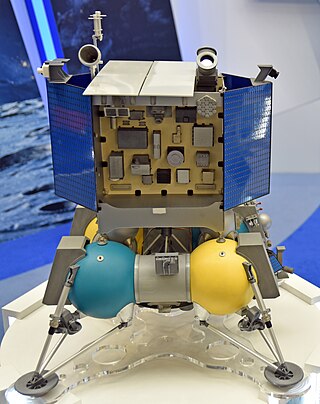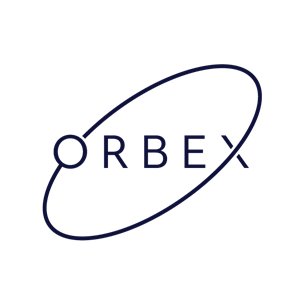Related Research Articles

Luna 16 was an uncrewed 1970 space mission, part of the Soviet Luna program. It was the first robotic probe to land on the Moon and return a sample of lunar soil to Earth. The 101 grams sample was returned from Mare Fecunditatis. It represented the first successful lunar sample return mission by the Soviet Union and was the third lunar sample return mission overall.

Luna 24 was a robotic probe of the Soviet Union's Luna programme. The 24th mission of the Luna series of spacecraft, the mission of the Luna 24 probe was the third Soviet mission to return lunar soil samples from the Moon. The probe landed in Mare Crisium. The mission returned 170.1 g (6.00 oz) of lunar samples to the Earth on 22 August 1976.
Human spaceflight programs have been conducted, started, or planned by multiple countries and companies. Until the 21st century, human spaceflight programs were sponsored exclusively by governments, through either the military or civilian space agencies. With the launch of the privately funded SpaceShipOne in 2004, a new category of human spaceflight programs – commercial human spaceflight – arrived. By the end of 2022, three countries and one private company (SpaceX) had successfully launched humans to Earth orbit, and two private companies had launched humans on a suborbital trajectory.
Funding is the act of providing resources to finance a need, program, or project. While this is usually in the form of money, it can also take the form of effort or time from an organization or company. Generally, this word is used when a firm uses its internal reserves to satisfy its necessity for cash, while the term financing is used when the firm acquires capital from external sources.

Blue Origin Enterprises, L.P., commonly referred to as Blue Origin is an American aerospace manufacturer, government contractor, launch service provider, and space technologies company headquartered in Kent, Washington, United States. The company makes rocket engines for United Launch Alliance (ULA)'s Vulcan rocket and manufactures their own rockets, spacecraft, satellites, and heavy-lift launch vehicles. The company is the second provider of lunar lander services for NASA's Artemis program and was awarded a $3.4 billion contract. The four rocket engines the company has in production are the BE-3U, BE-3PM, BE-4 and the BE-7.

A space capsule is a spacecraft designed to transport cargo, scientific experiments, and/or astronauts to and from space. Capsules are distinguished from other spacecraft by the ability to survive reentry and return a payload to the Earth's surface from orbit or sub-orbit, and are distinguished from other types of recoverable spacecraft by their blunt shape, not having wings and often containing little fuel other than what is necessary for a safe return. Capsule-based crewed spacecraft such as Soyuz or Orion are often supported by a service or adapter module, and sometimes augmented with an extra module for extended space operations. Capsules make up the majority of crewed spacecraft designs, although one crewed spaceplane, the Space Shuttle, has flown in orbit.
Excalibur Almaz was a private spaceflight company which planned to provide a variety of deep space crewed exploration missions, micro-gravity science, and payload delivery. EA also aimed to offer Low Earth Orbit cargo and crew delivery and return.
The Moon Lightweight Interior and Telecoms Experiment (MoonLITE), was a proposed British space mission to explore the Moon and develop techniques for future space exploration. If funded, it would have been built by a consortium of UK industry likely including Surrey Satellite Technology, and it was planned to be launched into lunar orbit in 2014. The mission concept emerged from a study run by the Particle Physics and Astronomy Research Council in 2006. In December 2008, the British National Space Centre announced that the project was moving to a 12-month Phase A study of the mission systems and the planned penetrators.

Kickstarter, PBC is an American public benefit corporation based in Brooklyn, New York, that maintains a global crowdfunding platform focused on creativity. The company's stated mission is to "help bring creative projects to life". As of February 2023, Kickstarter has received US$7 billion in pledges from 21.7 million backers to fund 233,626 projects, such as films, music, stage shows, comics, journalism, video games, board games, technology, publishing, and food-related projects.

Chang'e 5 was the fifth lunar exploration mission in the Chinese Lunar Exploration Program of CNSA, and China's first lunar sample-return mission. Like its predecessors, the spacecraft is named after the Chinese moon goddess, Chang'e. It launched at 20:30 UTC on 23 November 2020, from Wenchang Spacecraft Launch Site on Hainan Island, landed on the Moon on 1 December 2020, collected ~1,731 g (61.1 oz) of lunar samples, and returned to the Earth at 17:59 UTC on 16 December 2020.
Video game development has typically been funded by large publishing companies or are alternatively paid for mostly by the developers themselves as independent titles. Other funding may come from government incentives or from private funding.

SpaceIL is an Israeli organization, established in 2011, that competed in the Google Lunar X Prize (GLXP) contest to land a spacecraft on the Moon.

Chang'e 6 was the sixth robotic lunar exploration mission by the China National Space Administration (CNSA) and the second CNSA lunar sample-return mission. Like its predecessors in the Chinese Lunar Exploration Program, the spacecraft is named after the Chinese moon goddess Chang'e. It was humanity's first lunar mission to retrieve samples from the far side of the Moon, as all previous collective sample-return missions were done from the near side.

Luna 27 is a planned lunar lander mission by the Roscosmos with collaboration by the European Space Agency (ESA) to send a lander to the South Pole–Aitken basin, an area on the far side of the Moon. Its objective will be to detect and characterise lunar polar volatiles. The mission is a continuation of the Luna-Glob programme.
Crowdfunding is the practice of funding a project or venture by raising money from a large number of people, typically via the internet. Crowdfunding is a form of crowdsourcing and alternative finance. In 2015, over US$34 billion was raised worldwide by crowdfunding.

Luna 26 is a planned lunar polar orbiter, part of the Luna-Glob program, by Roscosmos. In addition to its scientific role, the Luna 26 orbiter would also function as a telecomm relay between Earth and Russian landed assets. This mission was announced in November 2014, and its launch is planned for 2027 on a Soyuz-2.1b launch vehicle.

Orbital Express Launch Ltd., or Orbex, is a United Kingdom-based aerospace company that is developing a small commercial orbital rocket called Prime. Orbex is headquartered in Forres, Moray, in Scotland and has subsidiaries in Denmark and Germany. Its future launch complex, Sutherland spaceport, is being built on the A' Mhòine peninsula in the county of Sutherland, northern Scotland.

Beresheet was a demonstrator of a small robotic lunar lander and lunar probe operated by SpaceIL and Israel Aerospace Industries. Its aims included inspiring youth and promoting careers in science, technology, engineering, and mathematics (STEM), and landing its magnetometer, time capsule, and laser retroreflector on the Moon. The lander's gyroscopes failed on 11 April 2019 causing the main engine to shut off, which resulted in the lander crashing on the Moon. Its final resting position is 32.5956°N, 19.3496°E.

The Artemis program is a Moon exploration program that is led by the United States' National Aeronautics and Space Administration (NASA) and was formally established in 2017 via Space Policy Directive 1. The Artemis program is intended to reestablish a human presence on the Moon for the first time since the Apollo 17 moon mission in 1972. The program's stated long-term goal is to establish a permanent base on the Moon to facilitate human missions to Mars.
The Lunar Polar Exploration Mission (LUPEX) is a planned joint lunar mission by the Indian Space Research Organisation (ISRO) and Japan Aerospace Exploration Agency (JAXA). The mission would send an uncrewed lunar lander and rover to explore the south pole region of the Moon no earlier than 2026. It is envisaged to explore the permanently shadowed regions on the Moon. JAXA is likely to provide the H3 launch vehicle and the rover, while ISRO would be providing the lander.
References
- ↑ "Lunar Mission One: A New Lunar Mission for Everyone". British Interplanetary Society. 19 November 2014. Archived from the original on 20 October 2020. Retrieved 2 March 2015.
- 1 2 Summary of 2017 Archived 2018-05-01 at the Wayback Machine . 15 January 2018. Lunar Mission One.
- ↑ Pallab Ghosh (8 December 2014). "UK researchers set out goals for Lunar Mission One". BBC News . Retrieved 2 March 2015.
- ↑ Wall, Mike; November 19, Space com Senior Writer |; ET, 2014 10:49am (19 November 2014). "Private Moon Mission Aims to Drill Into Lunar South Pole by 2024". Space.com. Retrieved 27 January 2019.
{{cite web}}: CS1 maint: numeric names: authors list (link) - ↑ Pallab Ghosh (19 November 2014). "UK 'to lead moon landing' funded by public contributions". BBC News . Retrieved 2 March 2015.
- ↑ Katie Collins (16 December 2014). "UK successfully crowdfunds lunar mission". Wired . Retrieved 2 March 2015.
- ↑ "LUNAR MISSION ONE: A new lunar mission for everyone". Kickstarter . Retrieved 2 March 2015.
- ↑ Parnell, Brid-Aine. "Non-profit Moon Mission Falls Foul Of The Crowdfunding Tax Conundrum". Forbes. Retrieved 27 January 2019.
- ↑ "The Trust". Lunar Mission One. Retrieved 2 March 2015.
- ↑ "Lunar Missions Trust closure - update May 2023". Lunar Mission One. May 2023. Retrieved 8 July 2024.
- ↑ "Lunar Mission One". Lunar Mission One. Retrieved 2 March 2015.
- ↑ "Lunar Mission One: An Announcement about Future Changes - 2019". Lunar Mission One. January 2019.